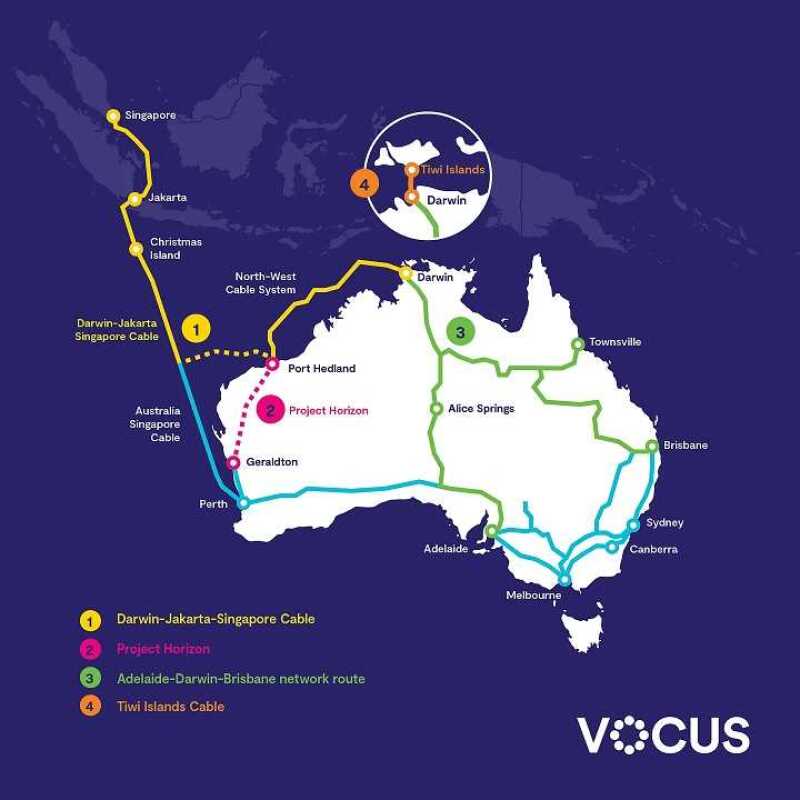August saw Australian telco Vocus announced plans to deliver the first international subsea cable connection into Darwin, Australia, with the interconnection of its 4,600km Australia Singapore Cable (ASC) with its 2,100km North West Cable System (NWCS) with a new $100 million, 1,000km cable.
The new link will form the final piece of the Darwin-Jakarta-Singapore Cable (DJSC), a $500 million system that spans Perth, Darwin, Port Hedland, Christmas Island, Indonesia and Singapore.
Speaking to Andrew Wildblood, Vocus' chief executive of Enterprise and Government, he shared some insight into the drivers behind the decision to create DJSC and the benefits it will deliver. Unsurprisingly he says the system "serves a number of purposes".
"It establishes new international capacity entry points into Port Hedland and Darwin, providing Vocus with even greater redundancy on our domestic and international network when outages occur," he says.
"It will interconnect with Project Horizon, our in-progress cable from Perth to Port Hedland and onto Darwin through the Pilbara mining region, providing another redundant loop in our inter-capital network. And it will also provide connectivity for offshore oil and gas operators beyond the reach of the existing North West Cable System."
As we know the ongoing has played its part in the acceleration of global digitisation which in turn has accelerated three key trends according to Wildblood.
The first is the acceleration of digitisation and resulting demand for bandwidth. Second is the increased focus on network security and third is the heightened customer demand for speed, flexibility and value.
"Covid saw both Enterprise and Government customers rapidly shift their workforces to work-from-home environments, requiring a significant uplift un bandwidth and changes to their networks which we were able to deliver in record time," explains Wildblood.
"This is the ‘new normal’, and we don’t expect network requirements to ever go back to pre-pandemic levels."
With DJSC being the final stage in a number of infrastructure builds by Vocus, Project Horizon, the company's terrestrial cable "will establish the first competitive terrestrial fibre connection from Perth to Port Hedland and onto Darwin", says Wildblood.
"The combination of the new Port Hedland-ASC link, Project Horizon, and the broader DJSC system will provide Vocus customers with a number of new redundant routes to ensure continuity of service even when breaks or disruptions occur."
Specifically, the combination of Project Horizon and the DJCS means that traffic can be re-routed via domestic and international links through Port Hedland and/or Darwin, creating a low-latency route to South East Asia which does not rely on the international links of Perth or Sydney.

The biggest drivers of these infrastructure builds over at Vocus continues to be the resources, mining, oil and gas sectors as Wildblood says they "increase their use of automation and data-driven operations".
Other drivers include the deployment of numerous LEO Satellite networks as its increased investment is "increasing capacity on Vocus’ extensive regional networks".
Additionally, the deployment of 5G networks will also drive demand for high-bandwidth, low latency backhaul.
"Over the top (OTT) and cloud traffic is driving demand for capacity both internationally and domestically, with the recent development of Edge computing driving investment in Vocus’ extensive regional fibre network," he adds.
Like all major subsea projects, the presence of such connectivity can lead to significant maturation of its digital ecosystem and sometimes additional investment in things like data centre, IX or edge facilities to manage the incoming traffic. DJSC will be no exception.
Wildblood explains that as Singapore has put a moratorium on new data centres due to insufficient power infrastructure, the Northern Territory Government has expressed its intention to attract hyperscale data centres to Australia’s North.
"Both the DJSC and Project Horizon are designed to provide future-proofed capacity between Australia’s North and West and major regional data hubs like Singapore, and these new fibre links will be fundamental to attracting new datacentres to parts of Australia with abundant land and renewable energy," he says.
Due to complete in 2023, the DJSC will deliver 40Tbps capacity between Australia and Asia, and as a self-described fibre infrastructure company, the company will continue its focus "on meeting the market demand for high-capacity, low-latency fibre in Australia, New Zealand, and onto the Asia-Pacific region."
At present the company's national network can provide more than 50x the capacity it has provisioned today at economic levels of incremental investment.
"As technology improves, we expect to be able to expand beyond this. We are already upgrading our Sydney-Melbourne-Adelaide inter-capital direct routes to deliver 4x more capacity," he says.
The company has already begun the upgrade of its Sydney-Brisbane routes "connecting regional centres to deliver 20x more capacity and with Nokia we have now completed the upgrades to our Adelaide-Darwin-Brisbane route to offer a 25x increase in capacity".
Last of all, following Vocus’ completion of the construction of the Coral Sea Cable System to Papua New Guinea and the Solomon Islands on behalf of the Australian Government in 2019, Wildblood says it will "continue to pursue opportunities to assist the Government in its ‘Pacific Step Up’ strategy should more opportunities arise to improve connectivity throughout the Indo-Pacific region".









